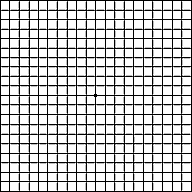
Macular degeneration is the deterioration or the breakdown of the macula – a small area in the retina at the back of the eye. Macular degeneration affects vision both near and far. Macular degeneration can result in central vision that is blurry, with dark areas or distortion, making activities like reading or threading a needle difficult or impossible.
The macula enables a person to see fine details and to perform activities such as reading and driving. Macular degeneration reduces the quality of vision in the central part of the retina, but it does not affect the eye’s side or peripheral vision. For example, one could see the outline of a clock but would not be able to tell what time it is.
Macular degeneration alone does not result in total blindness, and in many cases the impact on vision can be minimal. In advanced cases, people may have little useful vision and may need assistance to care for themselves.
There are two common types of age-related macular degeneration: “dry” (atrophic) and “wet” (exudative).
“Dry” macular degeneration is caused by the aging and thinning of the tissues of the macula. Vision loss is gradual. This is the most common form of macular degeneration.
“Wet” macular degeneration results from abnormal blood vessels that form underneath the retina at the back of the eye. The new blood vessels leak fluid or blood, which blur central vision. Vision loss may be rapid and severe. About 10% of cases are the “wet” form of macular degeneration. TOP

This condition may be hardly noticeable in its early stages. Sometimes one eye loses vision while the other eye continues to see well for years. Common symptoms include:
Early stages of macular degeneration can be detected during a routine medical eye examination that includes:
There is no cure yet for “dry” macular degeneration, but some doctors believe that nutritional supplements may slow the deterioration. Certain types of “wet” macular degeneration can be treated in its early stages with laser surgery: a brief outpatient procedure in which a high energy beam of light is aimed directly onto the leaking blood vessels to seal them, stopping further vision loss. A new treatment, called photo-dynamic therapy, involves injecting a dye into the vein in the arm, then shining a specific, low energy laser light on the macula. The laser light is absorbed by the dye, causing the abnormal, leaking blood vessels to regress. TOP
Call (818) 762-0647 for a consultation.